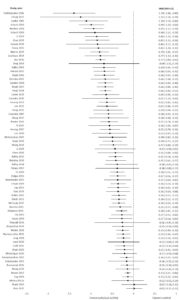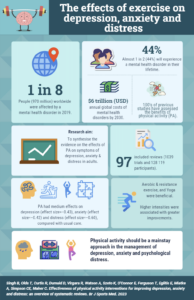Authors:
Ben Singh, Timothy Olds, Rachel Curtis, Dot Dumuid, Rosa Virgara, Amanda Watson, Kimberley Szeto, Edward O’Connor, Ty Ferguson, Emily Eglitis, Aaron Miatke, Catherine EM Simpson, Carol Maher.
Ben Singh, Alliance for Research in Exercise, Nutrition, and Activity (ARENA), University of South Australia, Adelaide, South Australia, Australia, Ben.Singh@unisa.edu.au
In this blog, we provide an overview of our new umbrella review (which is a systematic review of systematic reviews) which was published in the British Journal of Sports Medicine. In this study, we set out to undertake the most comprehensive analysis to date of evidence on the effects of all types of physical activity on depression, anxiety and distress in adults.
Why is this study important?
Almost one in every eight people (970 million) worldwide experienced a mental health disorder in 2019, and nearly half of all individuals will experience a mental health disorder at some point in their lives. The economic costs of these disorders are substantial, with estimated global costs of $2.5 trillion (USD) per year, and this figure is expected to rise to $6 trillion (USD) by 2030. Depression is the leading cause of mental health-related disease burden, and anxiety is the most common mental health disorder. The COVID-19 pandemic has also led to increased rates of distress, with 35% to 38% of people affected worldwide. These figures highlight the urgent need to address mental health disorders and prioritise interventions to promote mental well-being.
Numerous research trials have investigated the potential benefits of physical activity for depression, anxiety, and distress in different populations, and at different dosages. Generally, results are positive, yet physical activity has not been widely adopted as a therapeutic intervention in clinical practice, as is often viewed as being “alternative”. Challenges such as patient resistance, difficulties with prescribing and monitoring physical activity in clinical settings, and the large number of disparate studies have likely contributed to the limited implementation of physical activity interventions in mental health treatment.
How did the study go about this?
We searched for all systematic reviews with meta-analyses of randomised controlled trials designed to increase physical activity in an adult population and that assessed depression, anxiety or distress and summarised the findings. We also performed subgroup analyses to identify whether effects varied for different clinical populations, and for different physical activity modes and intensities.
What did the study find?
There are thousands of research trials examining the impact of physical activity for treating anxiety, depression and/or stress. Our review included a total of 97 systematic review, comprising of 1039 trials and 128 119 participants. Taken together, results clearly show that physical activity had moderate effects on depression (median effect size=−0.43, Figure 1), anxiety (median effect size=−0.42, Figure 2) and psychological distress (effect size=−0.60), compared with usual care across all populations. The largest benefits were seen in people with depression, HIV and kidney disease, in pregnant and postpartum women, and in healthy individuals. Higher intensity physical activity was associated with greater improvements in symptoms. Effectiveness of physical activity interventions diminished with longer duration interventions. The size of these benefits was comparable to, and slightly larger than, the benefits of medications and psychotherapy.
Figure 1 Results of meta-analyses that assessed symptoms of depression using standardised mean differences (negative values represent a reduction in symptoms).

What are the key take-home points?
There is a very large rigorous body of scientific evidence showing that physical activity is effective for improving depression and anxiety. These benefits apply across a very wide range of populations. While all physical activity modes are effective, higher intensity physical activity is associated with greater benefit. The findings from this umbrella review underscore the significant potential for physical activity to improve mental health outcomes and support the integration of physical activity interventions in mental health treatment.
